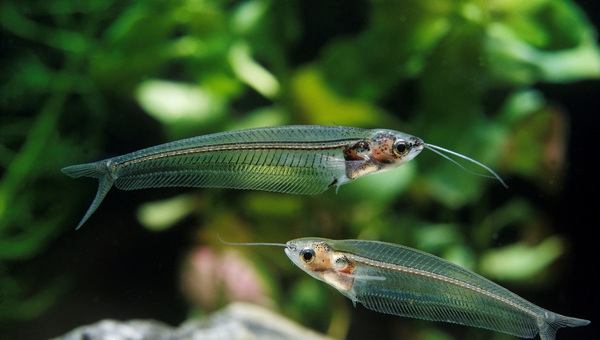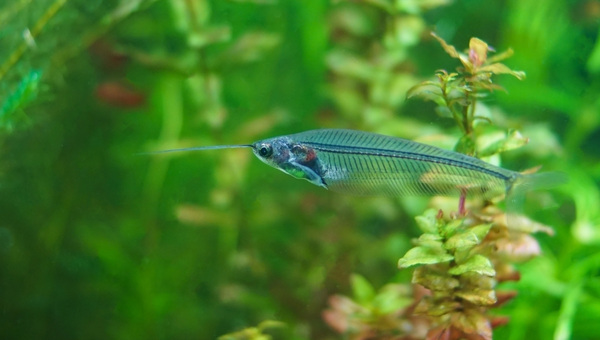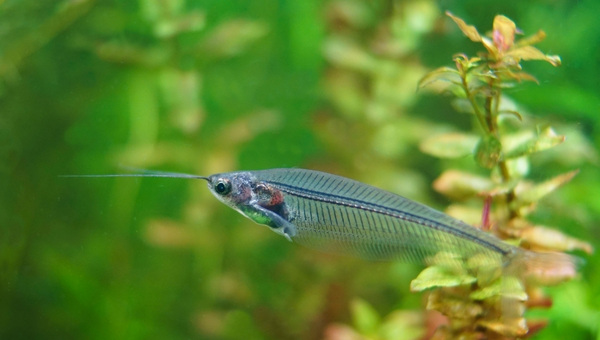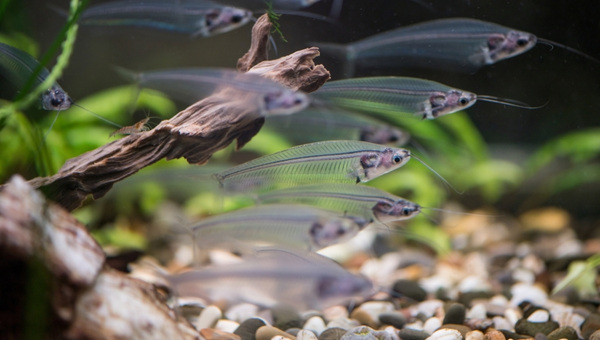Glass Catfish is a type of fish that is found in Thailand. It is a member of the family Siluridae and is closely related to the Corydoras catfish.
One of the most distinctive features of the Glass Catfish is its transparent, or “glass,” body.
This is a popular aquarium fish and is often kept by hobbyists for its unique appearance. It is a peaceful fish and does well when kept with other docile fish species. It is a freshwater fish and can be found in a variety of habitats, including streams, rivers, and lakes.
This guide will take a closer look at the Glass Catfish, including its physical characteristics, diet, and care requirements.
Table of Contents
- Species Summary
- Glass Catfish care
- Glass Catfish Tank Size
- Water Parameters
- Water Changes
- Filtration
- Heater
- Lighting
- Aquarium Decor
- Other Tank Accessories
- Cleaning The Tank
- Glass Catfish Common Possible Diseases
- Glass Catfish Treatment And Medications
- Glass Catfish Food & Diet
- Glass Catfish Diet Foods To Avoid
- Glass Catfish Tank Mates
- Glass Catfish Fish to Avoid
- The Importance Of A School
- Advantages Of Having Glass Catfish In Your Tank
- Disadvantages Of Having Glass Catfish In Your Tank
- Conclusion
Species Summary
| Scientific name: | Kryptopterus vitreolus |
| Other common names: | Glass Catfish, transparency catfish |
| Origin: | Thailand |
| Size: | 3 to 6 inches in length |
| Life span: | 7 to 8 years |
| Tank size: | 30 gallons or larger |
| Temperature range: | 75° to 80°Fahrenheit |
| pH range: | 6.0 to 7.0 |
| Water Hardness: | Soft to medium |
| Water Type: | Freshwater |
| Nature: | Calm |
| Compatibility: | Generally peaceful; can be kept with other docile fish species |
| Care Level: | Easy |
| Diet: | Omnivorous; eats a variety of foods, including insects, crustaceans, and plant material. |
It is found in rivers south of the Isthmus of Kra and drains into the Gulf of Thailand.

This small fish is related to the better-known Corydoras catfish and has a transparent or “glass” body.
Glass Catfish Appearance
As their name suggests, Glass Catfish have a transparent or “glass” body. This allows you to see the fish’s internal organs and skeletal structure. Their skin is also translucent, so you can see the red blood cells passing through their veins.

Some people find this feature fascinating, while others find it disturbing. This is not for you if you’re uncomfortable seeing your fish’s internal organs.
Glass Catfish Size & Growth Rate
The average Glass Catfish size is 3 to 4 inches in length, but they can grow as large as 6 inches. This is larger than the average Corydoras catfish size.

The Glass Catfish grows at a medium rate and will reach its adult size in about 1 year. Their tank size impacts their size; the larger the tank, the larger the Glass Catfish will grow.
Glass Catfish Lifespan
The average lifespan is 7 to 8 years, with a few living as long as 9 years. This is a solid lifespan for a small fish like the Glass Catfish.
Their lifespan can be shortened if they are kept in a tank that is too small or if the water conditions are not ideal. Ensure you provide a large enough tank and meet the water requirements to ensure your fish has a long and healthy life.
Glass Catfish Behavior & Temperament
The behavior is typically very peaceful, and they will get along well with other fish in the tank. They are a good choice for both beginning and experienced aquarists. Glass Catfish have a calm temperament and will not harass other fish in the tank.
When choosing a Glass Catfish, select one that is active and has a healthy appearance. Avoid any fish that is sluggish or appears to be sick. Ask your local pet store associate for assistance if you have difficulty setting up a healthy fish.
Your Glass Catfish will also appreciate a well-decorated tank with plants and other aquarium decorations. This will help to create a natural environment for them and make them feel more at home.
Glass Catfish are an excellent choice for anyone looking for a peaceful and easy-to-care-for aquarium resident. By providing them with a healthy diet and a clean tank, you can help ensure they live long and happy lives.
Glass Catfish Breeding
Glass Catfish can be bred in a home aquarium with little effort.
To breed Glass Catfish, you will need to provide them with a tank of at least 10 gallons in size and plenty of hiding places. You will also need to give them a diet of live food.
To induce breeding, you will need to decrease the water temperature in the tank to about 75 degrees Fahrenheit. You can do this by using an air conditioner or placing the tank in a cold room.
Once the fish are breeding, you will notice that the female will release her eggs into the male’s mouth. The male will fertilize the eggs and release them back into the tank.

The eggs will hatch in about three days, and the fry will be ready to eat after a week.
Be sure to provide plenty of food for the fry, as they will need to eat frequently to grow. You can also use exceptional fry food to help them grow.
Glass Catfish are easy to breed and make a great addition to any home aquarium. You can experience the joy of producing your fish by following these simple steps.
Other Characteristics
The Glass Catfish has a long, slender body that is slightly compressed from side to side. They have a small head and a broad tail.
Their body color can vary, but it is typically light brown or gray. Some fish have a faint stripe that runs along their body length.
One thing that makes the Glass Catfish unique is its ability to change color. They can turn light brown, gray, or black to blend in with their environment.
The Glass Catfish can be easily differentiated from other catfish species because of its transparent body. They are also smaller in size than most other catfish.
Glass Catfish have barbels on their chin to find food in the dark. They also have a pair of long “whiskers” on their head to feel around in their environment.
Glass Catfish care
Glass Catfish care is relatively easy, making them a good choice for beginner fish keepers. They are generally peaceful fish and can be kept with other docile fish species, so they do well in community tanks. They will eat most types of food, so they are easy to feed.
As with any other fish, providing a large enough tank and meeting the water requirements is essential to ensure your Glass Catfish has a long and healthy life.
Instead, it’s all about being consistent with their care. Here are some basics that you’ll need to know to keep your Glass Catfish healthy and happy:
Glass Catfish Tank Size
The Glass Catfish is a small fish and does well in 30 gallons or larger tanks. Larger tanks will allow the fish to grow to their full-size potential.
We don’t recommend going any smaller than 30 gallons, as the fish will be cramped and may not have a long lifespan.
This assumes that you are meeting all the other water requirements, which we will discuss in a bit.
Water Parameters
While Glass Catfish care is easy, meeting the water requirements is essential to keeping your fish healthy.
The water parameters you should aim to keep in your tank are:
- pH level: pH level should be between 6.0 and 7.0
- Ammonia level: Ammonia level should be 0
- Nitrite level: Nitrite level should be 0
- Nitrate level: Nitrate level should be below 20
- Water Temperature: The water temperature should be kept at 75° to 80°.
You may need to adjust your water parameters to match your local water conditions. If your water is hard or alkaline, use a water conditioner to soften it and make it more acidic. You can also use a fish tank pH adjuster to change the pH level of your tank.
Water Changes
You should perform water changes regularly to keep the water parameters in your tank stable. We recommend changing 20-25% of the water each week.
Filtration
To keep the water parameters in your tank stable, you will need to use a filtration system. A sound filtration system will remove waste and debris from the water, helping to keep your fish healthy. And also, remember to Clean your Filter Media Monthly for Optimum Performance.
Some recommended filters are:
- Aqua clear 70 Filter: These filters are great for freshwater and saltwater tanks. They remove waste, debris, and excess medication from the water.
- Aqua Cera CF series filters: These filters are designed specifically for Glass Catfish tanks. They remove ammonia, nitrite, and nitrate from the water, helping to keep your fish healthy.
- Aqueon Quiet Flow Fish Tank Filter: This filter is designed to be quiet and unobtrusive. It removes waste, debris, and excess medication from the water.
- Eheim Classic 2217 Filter: This high-quality filter is designed for tanks up to 265 gallons. It removes ammonia, nitrite, and nitrate from the water.
Heater
A heater is necessary to keep the water in your tank at a stable temperature. We recommend using a heater that is designed for Glass Catfish tanks.
Some recommended heaters are:
- Marineland Stealth 50 W Heater: This is designed to be quiet and unobtrusive. It heats the water to a stable temperature, making it a good choice.
- Aquatop Aquarium Heater: This heater is designed to be safe for both freshwater and saltwater tanks. It heats the water to a stable temperature, making it a good choice.
Lighting
Glass Catfish do well in tanks with moderate lighting. We recommend using a light that is designed for Glass Catfish tanks.
Some recommended lights are:
- Marineland LED Strip Light: This light is designed to be used on tanks up to 55 gallons. It provides a moderate lighting level, making it a good choice for Glass Catfish tanks.
- Aqueon LED Aquarium Light: This light is designed to be used on tanks up to 55 gallons. It provides a moderate lighting level, making it a good choice for Glass Catfish tanks.
Aquarium Decor
Glass Catfish are schooling fish and do best when they have plenty of hiding places. We recommend using aquarium decor to provide them with hiding places. Some recommended aquarium decor are:
- Anubias Nana: This plant is hardy and easy to care for. It provides a good hiding place.
- Driftwood: Driftwood can be used to create a natural look in your tank. It provides a good hiding place.
- Java Fern: This plant is also hard and easy to care for. It provides a good hiding place.
Other Tank Accessories
Other tank accessories that you may want to consider are:
- Heater guard: This heat-resistant shield can protect your heater from being damaged.
- Thermometer: This is a thermometer that can be used to monitor the temperature of your tank.
- Fish net: This net can catch and move fish in your tank.
- Water test kit: This kit can test the water parameters in your tank.
If you are looking for a fish that is easy to care for and does well in a community tank, then the Glass Catfish may be the right choice for you.
Cleaning The Tank
One of the most important things you need to do to keep your fish healthy is clean their tank. To clean the tank, you will need to use a filtration system. A sound filtration system will remove waste and debris from the water, helping to keep your fish healthy. And also, remember to Clean your filter every month.
It would be best if you also cleaned the tank every two weeks. To do this, you will need to remove the fish and the décor from the tank. You can then use a gravel vacuum to clean the gravel. Rinse the décor in warm water before returning it to the tank. And remember to add fresh water to the tank before returning the fish.
If you have a lot of algae in your tank, you can use an algae scraper to remove it. Be sure to clean both the sides and the bottom of the tank. You can also use an aquarium vacuum to suck up any debris on the bottom of the tank.
And lastly, you should clean the glass of the tank every month. You can do this by using a glass cleaner and a paper towel. Be sure to rinse the tank with warm water after cleaning it.
By following these simple steps, you can keep your fish healthy and help to maintain a clean tank.
Glass Catfish Common Possible Diseases
Just like any other type of fish, Glass Catfish can get sick.
Some common possible diseases that they can get are:
- Fin rot: This disease causes the fins to become inflamed and disintegrate. It is caused by bacteria that live in the water. The best way to treat this disease is to use a medication specifically designed for treating fin rot. If the condition is caught early, it can often be treated successfully.
- Pop-eye: This condition causes one or both eyes to protrude from the head. It is caused by bacteria or a virus and can often be treated with antibiotics or antiviral medication.
- Columnaris: This is a bacterial infection that affects the gills and mouth of the fish. It can often be treated with antibiotics.
- Ich: Ich is a parasitic infection that causes small white spots on the fish’s body. It is caused by a protozoan and can often be treated with medication.
- White spot disease: This is a parasitic infection that causes small white spots to form on the fish’s body. It is caused by a protozoan and can often be treated with medication.
Suppose you notice that your Glass Catfish is not acting like itself, or if it has any of the symptoms listed above, you should take it to a veterinarian for diagnosis and treatment. Catching the disease early can improve the chances of a successful outcome.
Glass Catfish Treatment And Medications
Several treatments and medications are available for treating diseases in fish.
Some of the most common medications include:
- Amoxicillin: This antibiotic is used to treat several bacterial infections in fish.
- Metronidazole: This antibiotic is used to treat several parasitic infections in fish.
- Tetracycline: This antibiotic is used to treat several bacterial infections in fish.
- Quinine: This medication is used to treat several parasitic infections in fish.
- Erythromycin: This antibiotic is used to treat several bacterial infections in fish.
- Kanamycin: This antibiotic is used to treat several bacterial infections in fish.
- Nitrofurazone: This medication is used to treat several bacterial infections in fish.
Using the proper medication can often improve the chances of a successful outcome for your fish. Always consult with your veterinarian before starting any treatment.
Glass Catfish Food & Diet
Glass Catfish are omnivorous and will eat a variety of foods. They can be fed a diet consisting of live and frozen foods, pellets, and flakes.
Some good food choices for your Glass Catfish include:
- Bloodworms: These are small red worms that are found in freshwater. They are a good source of protein and vitamins.
- Mosquito larvae: These are the larvae of the mosquito. They are a good source of protein and minerals.
- Earthworms: These are long, slender worms that live in the soil. They are a good source of protein, lipids, and minerals.
- Frozen brine shrimp: This is a freeze-dried type of shrimp. It is a good source of protein, lipids, and minerals.
- Pellets: There are various types of pellets available for fish. They are a good source of protein, carbohydrates, and vitamins.
- Flakes: There are various types of flakes available for fish. They are a good source of protein, carbohydrates, and vitamins.
Some vegetables that can be fed to Glass Catfish include:
- Zucchini: This type of squash is dark green. It is a good source of fiber, vitamins A and C, and potassium.
- Broccoli: This is a vegetable that is dark green. It is a good source of fiber and potassium.
- Carrots: These are orange in color and are a good source of fiber, beta carotene, vitamins A and C, and potassium.
- Green beans are a good source of fiber, vitamin C, and potassium.
By providing your Glass Catfish with a balanced diet, you can help to keep them healthy and vibrant. Be sure to vary the type of food that you feed them regularly to ensure that they receive all the nutrients they need.
Glass Catfish Diet Foods To Avoid
There are several foods that you should avoid feeding your Glass Catfish.
Some of the most common foods to avoid include:
- Raw meat: This can contain harmful bacteria that can cause disease in fish.
- Salty foods: Too much salt can harm fish and lead to health problems.
- Fish food: Feeding your Glass Catfish and other fish as food can introduce parasites into their system.
By avoiding these types of food, you can help to keep your Glass Catfish healthy and happy.
Glass Catfish Tank Mates
The number of Glass Catfish tankmates you can keep in your tank depends on the size. A good rule of thumb is to have one inch of fish per gallon of water. So, if you have a 10-gallon tank, you can safely keep up to 10 Glass Catfish.
If you want to add other fish to your tank, choose species compatible with Glass Catfish.
Some good choices include:
- Corydoras: These small, bottom-dwelling fish are peaceful and get along well with other fish.
- Gouramis: These fish are territorial and should only be kept in tanks of a large enough size.
- Angelfish: These large fish are peaceful and make an excellent addition to any tank.
- Goldfish: These are popular for a community tank and will get along well with Glass Catfish.
- Barbs: Various types of barbs make good tank mates for Glass Catfish.
- Guppies: These colorful fish will add interest to the aquarium and get along well with glass catfish.
- Catfish: Several different types of catfish can be kept with Glass Catfish.
By choosing compatible tankmates, you can help to ensure that your Glass Catfish live in a peaceful environment. Ask your local pet store associate for advice on choosing compatible fish.
Glass Catfish Fish to Avoid
Glass Catfish are peaceful fish that get along well with other fish. However, a few types of fish should not be kept with Glass Catfish.
These include:
- Pacu: These large, aggressive fish can easily out-compete smaller fish for food and space.
- Cichlids: These aggressive fish can be territorial and will harass smaller fish.
- Tiger barbs: These aggressive, predatory fish can easily outcompete smaller fish for food.
The Importance Of A School
Like other fish in the catfish family, Glass Catfish do best when kept in a school of three or more. A lone Glass Catfish can become stressed and may not live as long as those that are part of a school.
When choosing your Glass Catfish, purchase at least three fish. This will help to create a more natural environment for them and make them feel more comfortable in their surroundings.
If you already have a Glass Catfish tank, consider adding more fish. This will help brighten the tank and make it more interesting to watch.
Aquarium hobbyists often keep different types of fish together in a community tank. This is a tank where all of the fish get along well with each other. You can create a beautiful and peaceful community tank by choosing compatible fish.
Advantages Of Having Glass Catfish In Your Tank
- The first advantage of keeping Glass Catfish in your tank is that they are very peaceful fish. They get along well with other fish and will not harass or bully other fish in the tank.
- The second advantage is that they are schooling fish. This means they do best when kept in groups of three or more. A lone Glass Catfish can become stressed and may not live as long as those that are part of a school.
- The third advantage is that they are easy to breed. By following the simple steps outlined above, you can experience the joy of producing your fish.
So, if you’re looking for a peaceful and easy-to-breed fish, the Glass Catfish might be right.
Disadvantages Of Having Glass Catfish In Your Tank
- The burden of keeping Glass Catfish in your tank is that they can be easily outcompeted for food by larger, more aggressive fish.
- Another disadvantage is that they can be territorial and will harass smaller fish.
By understanding the pros and cons of keeping Glass Catfish in your tank, you can make an informed decision about whether or not they are the right fish for you. Always ask your local pet store associate for advice on choosing compatible fish and setting up a tank for them. You can also find more information online.
Conclusion
Glass Catfish care is a fun and easy way to get into the aquarium hobby. These fish are peaceful, easy to breed, and a great addition to any tank.
One of the most important things to remember when keeping Glass Catfish is to provide them with a school of three or more fish. A lone Glass Catfish can become stressed and may not live as long as those that are part of a school.
Be sure to provide plenty of food for the fry, as they will need to eat frequently to grow. Glass Catfish care is a fun and easy way to get into the aquarium hobby. These fish are peaceful, easy to breed, and a great addition to any tank. Thanks for reading!



